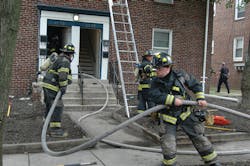Three Simple Ideas to a Healthier Fire Service
This is the second of three columns in which we revisit issues related to attaining the goal of a healthier fire service. The first installment (March 2011) covered effects of stress and overexertion on firefighters. This month, we look at the impact obesity has on firefighters. Our third column will focus on various forms of cancer that may be due to firefighters' exposure to toxins during their firematic duties.
Obesity is a recognized medical condition with potential for extreme consequences for firefighters. Obesity is defined as a body mass index (BMI) greater than 30. BMI is a calculation based on height and weight. Firefighters with morbid obesity should not be classified as interior-qualified Class A firefighters if their body mass index is more than 40.
Obesity is a contributing factor in many medical conditions, including Type 2 diabetes, stroke, gall bladder disease, arthritis, respiratory problems and some cancers. Furthermore, obesity is associated with increased rates of high blood pressure, high cholesterol and cardiovascular disease. Nowhere is the link to diabetes more significant than in the fact that overweight individuals tend to develop Type 2 diabetes at twice the rate of non-obese individuals. In America today, more than 80% of people with diabetes are overweight or obese.
We believe that while Americans in general become more obese, the issue for the fire service is to address this in terms of the obese firefighter's health and fireground safety of other firefighters. For these purposes, we identify extreme obesity with BMI over 40, otherwise known as morbid obesity, as a life-threatening medical condition.
Let's look at some reasons why obesity is such a significant problem for the fire service. As a personal health issue, obesity is a threat to the health and well-being of each individual firefighter. It raises the risk of cardiovascular disease and, ultimately, myocardial infarction, which may occur as a line-of-duty death. Furthermore, because firefighting is a physically demanding activity, it often happens that firefighters' cardiovascular disease shows itself on the fireground. We cannot afford to put high-risk individuals in situations where they cannot perform and complete their duties. Studies have documented that interior firefighting, stretching hoselines, ladder work, carrying tools and equipment, and other physical tasks require high levels of cardiovascular functioning. Extreme obesity impairs a firefighter's ability to perform cardiovascular activity and lowers exercise tolerance.
As we engage in this conversation with our fellow firefighters, we use one argument more persuasively than others when it comes to obesity. This issue is when we ask ourselves whether it is fair to put another firefighter at risk when a morbidly obese firefighter goes down in a structure fire. Can we ask a firefighter of average build and strength to carry a firefighter weighing 300 pounds during interior firefighting operations?
We believe this discussion may lead to an awareness of severe obesity affecting the safety of fireground operations. We would urge those in the leadership of the fire service to consider giving a one-year notice that going forward firefighters with a BMI greater than 40 will not be permitted to be classified as interior-qualified Class A firefighters.
We advocate that health-and-wellness programs be initiated within the fire service so that firefighters may improve their health, lower their weight and get in shape to remain interior-qualified Class A firefighters. A medical policy concerning morbid obesity can be adopted by every fire department to allow for a one-year grace period. This policy should be given to the departmental medical officer to implement so that all firefighters are personally told by the doctor what their situation is: Either get fit for duty or you will be categorically excluded from interior-qualified Class A duty.
DR. RAYMOND BASRI, MD, FACP, is in the private practices of internal medicine and diagnostic cardiology in Middletown, NY. Dr. Basri is a Diplomate of the American Board of Internal Medicine and president of the Mid-Hudson Section. He received the 2008 Laureate Award of the American College of Physicians, of which he is a Fellow. Dr. Basri also is clinical assistant professor of medicine at New York Medical College, attending physician in the Department of Internal Medicine at Orange Regional Medical Center and on the consulting staff in cardiology at The Valley Hospital in Ridgewood, NJ. He is a member of the Excelsior Hook and Ladder Company in Middletown and a deputy fire coordinator for Orange County. Dr. Basri is the senior physician of the Disaster Medical Assistance Team (DMAT NY-4). He is a senior aviation medical examiner for the Federal Aviation Administration (FAA) and chief physician for Health & Safety Specialists in Medicine, which does onsite medical examinations for the fire service and consultant to FirePhysicals.com.
ERIC BERGMAN, PA-C, is a physician assistant practicing internal medicine at Hartford Hospital in Hartford, CT. He earned a bachelor of science degree in allied health from the University of Connecticut and a master's degree from Albany Medical College. He is a member of the Killingworth, CT, Volunteer Fire Company; a past company officer and life member of the Avon, CT, Volunteer Fire Department; and a past member of the Shaker Road-Loudonville Fire Department in Colonie, NY.
